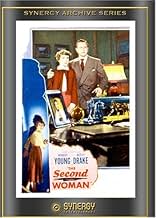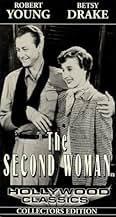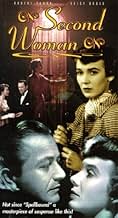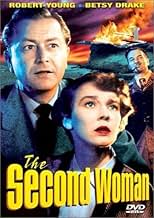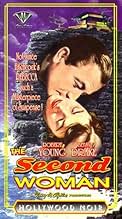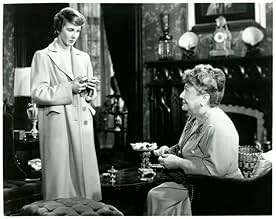Füge eine Handlung in deiner Sprache hinzuIn flashback from a 'Rebecca'-style beginning: Ellen Foster, visiting her aunt on the California coast, meets neighbor Jeff Cohalan and his ultramodern clifftop house.In flashback from a 'Rebecca'-style beginning: Ellen Foster, visiting her aunt on the California coast, meets neighbor Jeff Cohalan and his ultramodern clifftop house.In flashback from a 'Rebecca'-style beginning: Ellen Foster, visiting her aunt on the California coast, meets neighbor Jeff Cohalan and his ultramodern clifftop house.
- Stacy Rogers
- (as Jason Robards)
- Mr. Nelson
- (as Jimmy Dodd)
- Porter
- (Gelöschte Szenen)
- Country Club Guest
- (Nicht genannt)
- Giovanni Strobini
- (Nicht genannt)
- Country Club Guest
- (Nicht genannt)
Empfohlene Bewertungen
Is it a self-inflicted retribution ("he wants to be punished for what he's done) ,as the friendly doctor says , warning Helen and her aunt who accomodates him after the fire against a man who may become dangerous :he destroys everything he likes , and he loves you!
Or is there a criminal mind behind these strange events : hence a whodunit side: is it Ben,the late fiancée's father who treats Jeff like his own son?Keith the philanderer? Or the doctor himself ?
The screenplay sustains suspense throughout and the ending makes sense ; Robert Young as a brooding wistful man down on his luck and Betsy Drake, as headstrong energetic Helen come up to scratch.
Young plays an architect brooding over the death of his fiancé in an auto crash in which he was the driver the previous year. After a series of apparent accidents, including a suspicious injury to his horse and a fire at his house, it appears that either someone is out to get him, or he is actually doing destructive things to himself because he is a dangerously off-his-nut paranoiac. The local doctor (Morris Carnovsky) believes the latter. His newly acquired girl friend (Drake), who works in statistical studies for an insurance company, turns detective to prove it is the former. The mystery unfolds at a leisurely pace at first but gradually builds tension with surprising twists and turns of the plot. As with any good thriller, you begin to suspect everyone. A brooding, almost Gothic mood is maintained by Joseph Nussbaum's haunting Tchaikovsky-based score and Hal Mohr's alternately dark and luminous black and white cinematography. Frequent shots of the surf crashing on the lonely rocks of the Central California shore help set the forlorn ambiance. Kern's direction is precise, dialog is intelligent, editing smooth. Young and Drake are charming, and they get expert support from Carnovsky, Henry O'Neil, Florence Bates, and John Sutton.
The Second Woman successfully blends elements of mystery, noir, Gothic, and romantic melodrama. Though released in July 1950, its sensuous style and feel seem to belong more to the l940's than to the 'fifties. But when decades are accounted properly, the year 1950 is actually the last year of the decade we nickname "the forties". In any case it was made near the end of an era. Due to collapse of the studio systems, death and retirement of key personnel, adverse changes in public taste, and other factors, by the end of the 1950's they would no longer be able to make pictures as classy and entertaining as The Second Woman.
Top entertainment from Hollywood's Golden Era.
A chicly attired Betsy Drake - ironically Mrs Cary Grant at the time - provides an attractive and robust female lead.
"The Second Woman" is a decent film with good, if unexciting, acting. Robert Young made several noirs in the '40s, and he did them well - you really don't know here if he's sinister or if he's a victim. Drake is a bland costar. Carnovsky, O'Neill, Sutton and Bates give good support. Sutton strikes the right note as a man who hates Jeff.
Like dozens and dozens of post-World War II, there is an emphasis on psychology. Considering what our soldiers went through in World War II, it's not surprising that it was a hot topic. Here the big word is paranoia. But as anyone will tell you, just because you're paranoid doesn't mean someone's not out to get you.
Wusstest du schon
- WissenswertesAt the beginning of the movie, Robert Young's character tries to commit suicide by running his car engine in an enclosed garage. Then in flashback, the doctor says that he's concerned about Young's character's recurring bouts of depression. In real life, Young suffered from depression for decades, and tried to commit suicide in Westlake Village, CA in January 1991 by running a hose from his exhaust pipe into the interior of his car. Young called a tow truck to try to start his car. The driver noticed the hose, and contacted the police.
- PatzerIn the opening scene, Robert Young's character is discovered suffocated by heavy carbon monoxide in a sealed garage, but nobody else coming in the garage is affected by the deadly gas. Additionally, unless a car is burning oil or running very rich, exhaust fumes are not visible as was shown here. This reveals some type of smoke or vapor was used, not an actual auto exhaust.
- Zitate
Jeff Cohalan: Let's see what the tea leaves say about you... there's a trick my grandmother taught me; she learned it from an old witch in Ireland.
Ellen Foster: And so you've been drinking coffee ever since.
- VerbindungenReferenced in This Movie Must Die!: The Second Woman (1950) (2021)
Top-Auswahl
- How long is The Second Woman?Powered by Alexa
Details
- Laufzeit
- 1 Std. 31 Min.(91 min)
- Farbe
- Seitenverhältnis
- 1.33 : 1

